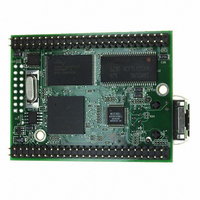MOD5272-100IR NetBurner Inc, MOD5272-100IR Datasheet - Page 159

MOD5272-100IR
Manufacturer Part Number
MOD5272-100IR
Description
PROCESSOR MODULE FLASH MOD5272
Manufacturer
NetBurner Inc
Type
Controllers & Processorsr
Datasheets
1.MOD5272-100IR.pdf
(2 pages)
2.MOD5272-100IR.pdf
(3 pages)
3.MOD5272-100IR.pdf
(550 pages)
Specifications of MOD5272-100IR
Module/board Type
Processor Module
Ethernet Connection Type
10/100 Ethernet Port RJ-45
Operating Voltage
3.3 V
Product
Modules
Lead Free Status / RoHS Status
Lead free / RoHS Compliant
For Use With/related Products
MOD5272
For Use With
528-1001 - KIT DEVELOP NETWORK FOR MOD5272
Lead Free Status / Rohs Status
Lead free / RoHS Compliant
Other names
528-1008
- Current page: 159 of 550
- Download datasheet (6Mb)
MOTOROLA
Note that the debug module requires the use of the internal bus to perform BDM
commands. In Revision A, if the processor is executing a tight loop that is contained within
a single aligned longword, the processor may never grant the internal bus to the debug
module, for example:
label1: nop
or
label2: bra.w label2
The processor grants the internal bus if these loops are forced across two longwords.
5.7 Processor Status, DDATA Definition
This section specifies the ColdFire processor and debug module’s generation of the
processor status (PST) and debug data (DDATA) output on an instruction basis. In general,
the PST/DDATA output for an instruction is defined as follows:
where the {...} definition is optional operand information defined by the setting of the CSR.
The CSR provides capabilities to display operands based on reference type (read, write, or
both). A PST value {0x8, 0x9, or 0xB} identifies the size and presence of valid data to
follow on the DDATA output {1, 2, or 4 bytes}. Additionally, for certain change-of-flow
branch instructions, CSR[BTB] provides the capability to display the target instruction
address on the DDATA output {2, 3, or 4 bytes} using a PST value of {0x9, 0xA, or 0xB}.
5.7.1 User Instruction Set
Table 5-22 shows the PST/DDATA specification for user-mode instructions. Rn represents
any {Dn, An} register. In this definition, the ‘y’ suffix generally denotes the source and ‘x’
denotes the destination operand. For a given instruction, the optional operand data is
displayed only for those effective addresses referencing memory.The ‘DD’ nomenclature
refers to the DDATA outputs.
Instruction
addq.l
addx.l
addi.l
add.l
add.l
and.l
align4
bra.b label1
align4
Table 5-22. PST/DDATA Specification for User-Mode Instructions
Operand Syntax
#imm,<ea>x
<ea>y,Rx
Dy,<ea>x
<ea>y,Dx
#imm,Dx
Dy,Dx
PST = 0x1, {PST = [0x89B], DDATA= operand}
PST = 0x1, {PST = 0xB, DD = source operand}
PST = 0x1, {PST = 0xB, DD = source}, {PST = 0xB, DD = destination}
PST = 0x1
PST = 0x1, {PST = 0xB, DD = source}, {PST = 0xB, DD = destination}
PST = 0x1
PST = 0x1, {PST = 0xB, DD = source operand}
Chapter 5. Debug Support
PST/DDATA
Processor Status, DDATA Definition
5-37
Related parts for MOD5272-100IR
Image
Part Number
Description
Manufacturer
Datasheet
Request
R

Part Number:
Description:
Ethernet Modules & Development Tools MOD5272 Processor Board
Manufacturer:
NetBurner Inc
Datasheet:

Part Number:
Description:
Ethernet Modules & Development Tools MOD5272 Industrial Temperature
Manufacturer:
NetBurner Inc

Part Number:
Description:
Ethernet Modules & Development Tools MOD5272 MODULE
Manufacturer:
NetBurner Inc
Datasheet:

Part Number:
Description:
PROCESSOR MODULE FLASH
Manufacturer:
NetBurner Inc
Datasheet:

Part Number:
Description:
Ethernet Modules & Development Tools 32Bit 62MHz Core Module 50Pin DIP
Manufacturer:
NetBurner Inc
Datasheet:

Part Number:
Description:
BOARD SERIAL-ETHERNET 512K FLASH
Manufacturer:
NetBurner Inc
Datasheet:

Part Number:
Description:
PROCESSOR MODULE 512KB FLASH
Manufacturer:
NetBurner Inc
Datasheet:

Part Number:
Description:
DUAL PORT SERIAL-ETHERNET
Manufacturer:
NetBurner Inc
Datasheet:

Part Number:
Description:
PROCESSOR MODULE 512KB FLASH
Manufacturer:
NetBurner Inc
Datasheet:

Part Number:
Description:
MOD5234 10/100 ETHERNET MODULE
Manufacturer:
NetBurner Inc
Datasheet:

Part Number:
Description:
KIT DEVELOP NETWORK FOR MOD5282
Manufacturer:
NetBurner Inc
Datasheet:

Part Number:
Description:
KIT DEVELOP NETWORK FOR MOD5272
Manufacturer:
NetBurner Inc
Datasheet:

Part Number:
Description:
Ethernet ICs 32bit 147MHz CAN-to- Ethnt Device IndTemp
Manufacturer:
NetBurner Inc
Datasheet:










